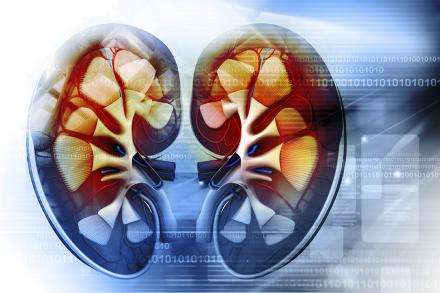Study reveals non-invasive warning sign of kidney disease progression

University of Michigan researchers have identified an accessible, non-invasive way to identify patients at risk for progression of kidney disease.
Together with the European Renal cDNA Bank and the Joint Institute for Translational and Clinical Research (a collaboration between Peking University Health Sciences Center and U-M), the U-M team found a simple, new test to identify one of the nation's fastest growing chronic illnesses.
Chronic kidney disease is a condition in which damaged kidneys cannot filter blood as well as healthy kidneys. Currently, it is estimated that over 10 million individuals suffer from chronic kidney disease, with the number of those affected continuing to rise.
A U-M team led by nephrologist Matthias Kretzler, M.D., renal systems biologist Wenjun Ju, Ph.D., M.S., and bioinformatician Viji Nair, M.S., has discovered a simple test to identify patients at risk for chronic kidney disease by measuring a specific molecule in a routine urine sample.
This molecule, a protein called epidermal growth factor, indicates whether the patient is at risk of end-stage kidney disease. End-stage kidney disease means an affected individual's kidneys can no longer meet their body's need to remove waste.
A decrease in urinary epidermal growth factor protein is an early sign of diminishing kidney function and pinpoints the at-risk patient population. While not all patients with chronic kidney disease will progress to end-stage kidney disease, those that do tend to advance quickly and require dialysis or kidney transplant. They are also at an increased risk of death from cardiovascular disease.
"Early identification of patients more likely to experience end-stage kidney disease is an urgent, unmet clinical need," Kretzler says. "Right now, kidney biopsy, which involves removing a tiny sample of kidney tissue, is the standard technique used to assess kidney disease. This procedure is costly, carries a low, but significant health risk, and has limited ability to predict the future course of kidney disease."
The international research team identified epidermal growth factor as a molecule of interest in kidney disease while analyzing kidney tissue biopsies from chronic kidney disease patients across Europe and the U.S. The researchers then validated the findings in urine samples from more than 940 patients in North America, Europe and China.
The research, published in Science Translational Medicine, linked decreased epidermal growth factor levels in urine to worsening kidney disease. In fact, patients with low urinary epidermal growth factor were four times more likely to worsen than those who retained epidermal growth factor function in their kidneys.
"Urinary epidermal growth factor can help patients in two very important ways," Kretzler says. "First, in clinical practice, it could be used to prioritize care to those patients most at risk of losing their kidney function."
"Second and more immediately, using urinary epidermal growth factor levels will improve and speed up clinical trials," he adds. "Enrolling only those likely to develop specific disease endpoints can reduce the number of people needing study and ensure the trial achieves an optimal mix of patients."
The researchers note urinary epidermal growth factor has the potential to reduce trial costs by as much as 75 percent, as well as shorten the time until a medicine is widely available to all patients.
According to the International Society of Nephrology, treatment of chronic kidney disease, including medical management, dialysis and kidney transplant, is very costly. In the U.S. alone, therapy for chronic kidney disease is likely to exceed $48 billion per year, and the end-stage kidney disease program consumes 6.7 percent of the total Medicare budget to care for less than 1 percent of the covered population. In China, the disease will cost the economy the equivalent of $558 billion in the U.S. over the next decade.
People with early-stage chronic kidney disease tend to not notice any symptoms. Once detected, chronic kidney disease can be treated with medicines and lifestyle changes, including healthier food and beverage choices. These treatments usually decrease the rate at which chronic kidney disease worsens, but cannot prevent progression.
"Understanding which patients are at risk for severe chronic kidney disease can lead to earlier and more effective treatments, thus preserving kidney function and helping patients lead longer and healthier lives," Kretzler says.
More information: W. Ju et al. Tissue transcriptome-driven identification of epidermal growth factor as a chronic kidney disease biomarker, Science Translational Medicine (2015). DOI: 10.1126/scitranslmed.aac7071















